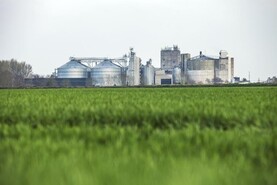New rules surrounding watercourse buffers have resulted in more uncultivated land being left beside watercourses than usual. Some will look at this as a positive, but tillage farmers are finding it a hard pill to swallow as more drains now need buffers than watercourses marked on maps.
The original 2m buffer is extended to 3m and more buffers have now been put in place by farmers afraid of inspection. This buffer stretches to 6m on late-harvested crops.
On a 4ha field (10ac) which is 200m in length and 200m in width and has a drain along the top and one side, that takes up 1,200m2 or 12% of 1ha which equates to one-third of an acre. If there were maincrop potatoes in that field, the area taken up by the buffer would be 2,400m2 or 24% of 1ha, equating to almost two-thirds of an acre. Take a look at Figure 1.
Water quality
It should be noted that the data on water quality to do with tillage is pointing towards soil type as one of the main issues.
Excess pesticide levels in water are most commonly associated with glyphosate and MCPA, both of which are mainly used on grassland. The only tillage area in 2022 with an excess level which was noted was Clonroche. In 2021, bentazone was the product in question.
Now, put all of this information beside the fact that livestock farmers do not even have to erect a fence beside a watercourse and can allow animals into streams and rivers unless they have a livestock stocking rate equal to or over 170kg/ha.
If the stocking rate is this high then a fence is needed just 1.5m from the top of the bank, not 3m. So this may help people to understand why it is a hard pill to swallow and why farmers across the country are annoyed at these rules.
There is also a risk of grass weeds establishing in this buffer which needs to be considered.
Incomes
Tillage incomes are already tight. The average tillage family farm income was estimated at €33,000 for 2023, before grain prices fell to just over €200/t. These buffer zones seem to be seen as a simple thing to do on farms, but when you see a quarter of an acre being lost which could be 1.25t of wheat or 1t of barley then that loss could put a nice dent in profits and is also resulting in a decline in crop production.
Tillage farms need to be kept in business, not put out of business.






 This is a subscriber-only article
This is a subscriber-only article









SHARING OPTIONS: